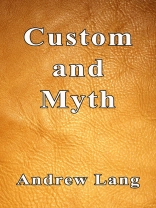After the heavy rain of a thunderstorm has washed the soil, it sometimes happens that a child, or a rustic, finds a wedge-shaped piece of metal or a few triangular flints in a field or near a road. There was no such piece of metal, there were no such flints, lying there yesterday, and the finder is puzzled about the origin of the objects on which he has lighted. He carries them home, and the village wisdom determines that the wedge-shaped piece of metal is a ‘thunderbolt, ’ or that the bits of flint are ‘elf-shots, ’ the heads of fairy arrows. Such things are still treasured in remote nooks of England, and the ‘thunderbolt’ is applied to cure certain maladies by its touch.
As for the fairy arrows, we know that even in ancient Etruria they were looked on as magical, for we sometimes see their points set, as amulets, in the gold of Etruscan necklaces. In Perugia the arrowheads are still sold as charms. All educated people, of course, have long been aware that the metal wedge is a celt, or ancient bronze axe-head, and that it was not fairies, but the forgotten peoples of this island who used the arrows with the tips of flint. Thunder is only so far connected with them that the heavy rains loosen the surface soil, and lay bare its long hidden secrets.
There is a science, Archæology, which collects and compares the material relics of old races, the axes and arrow-heads. There is a form of study, Folklore, which collects and compares the similar but immaterial relics of old races, the surviving superstitions and stories, the ideas which are in our time but not of it. Properly speaking, folklore is only concerned with the legends, customs, beliefs, of the Folk, of the people, of the classes which have least been altered by education, which have shared least in progress. But the student of folklore soon finds that these unprogressive classes retain many of the beliefs and ways of savages, just as the Hebridean people use spindle-whorls of stone, and bake clay pots without the aid of the wheel, like modern South Sea Islanders, or like their own prehistoric ancestors. {11a} The student of folklore is thus led to examine the usages, myths, and ideas of savages, which are still retained, in rude enough shape, by the European peasantry. Lastly, he observes that a few similar customs and ideas survive in the most conservative elements of the life of educated peoples, in ritual, ceremonial, and religious traditions and myths. Though such remains are rare in England, we may note the custom of leading the dead soldier’s horse behind his master to the grave, a relic of days when the horse would have been sacrificed. {11b} We may observe the persistence of the ceremony by which the monarch, at his coronation, takes his seat on the sacred stone of Scone, probably an ancient fetich stone. Not to speak, here, of our own religious traditions, the old vein of savage rite and belief is found very near the surface of ancient Greek religion. It needs but some stress of circumstance, something answering to the storm shower that reveals the flint arrow-heads, to bring savage ritual to the surface of classical religion. In sore need, a human victim was only too likely to be demanded; while a feast-day, or a mystery, set the Greeks dancing serpent-dances or bear-dances like Red Indians, or swimming with sacred pigs, or leaping about in imitation of wolves, or holding a dog-feast, and offering dog’s flesh to the gods. {12} Thus the student of folklore soon finds that he must enlarge his field, and examine, not only popular European story and practice, but savage ways and ideas, and the myths and usages of the educated classes in civilised races. In this extended sense the term ‘folklore’ will frequently be used in the following essays. The idea of the writer is that mythology cannot fruitfully be studied apart from folklore, while some knowledge of anthropology is required in both sciences.
Langue Anglais ● Format EPUB ● Pages 210 ● ISBN 9781365713927 ● Taille du fichier 0.8 MB ● Maison d’édition Sai ePublications ● Publié 2017 ● Téléchargeable 24 mois ● Devise EUR ● ID 5051724 ● Protection contre la copie sans



![Couverture du Brian Schrag & Julisa Rowe: Community Arts for God's Purposes [Chinese] 貼近神心意的社群藝術 Couverture du Brian Schrag & Julisa Rowe: Community Arts for God's Purposes [Chinese] 貼近神心意的社群藝術](https://static.world-of-digitals.com/thumb_webp/740/9781645083740.webp)








